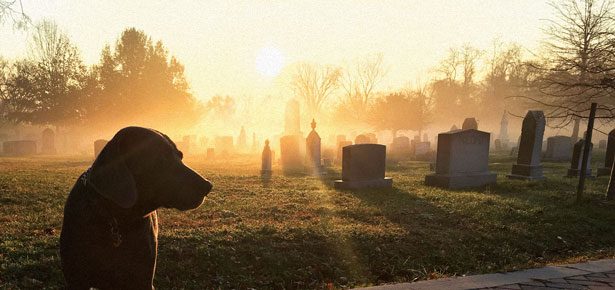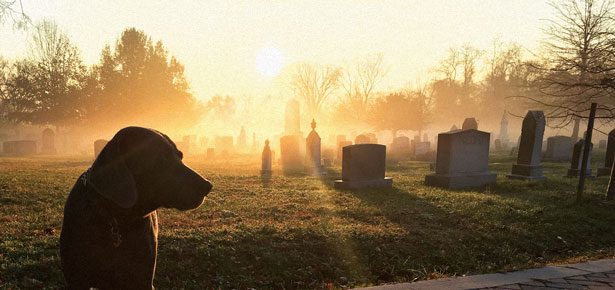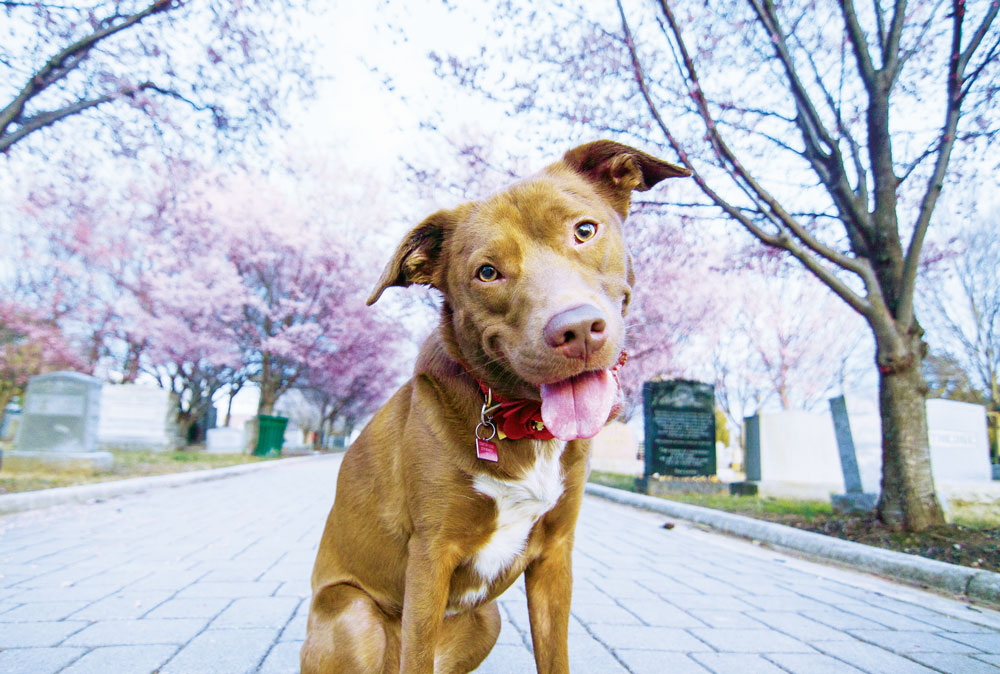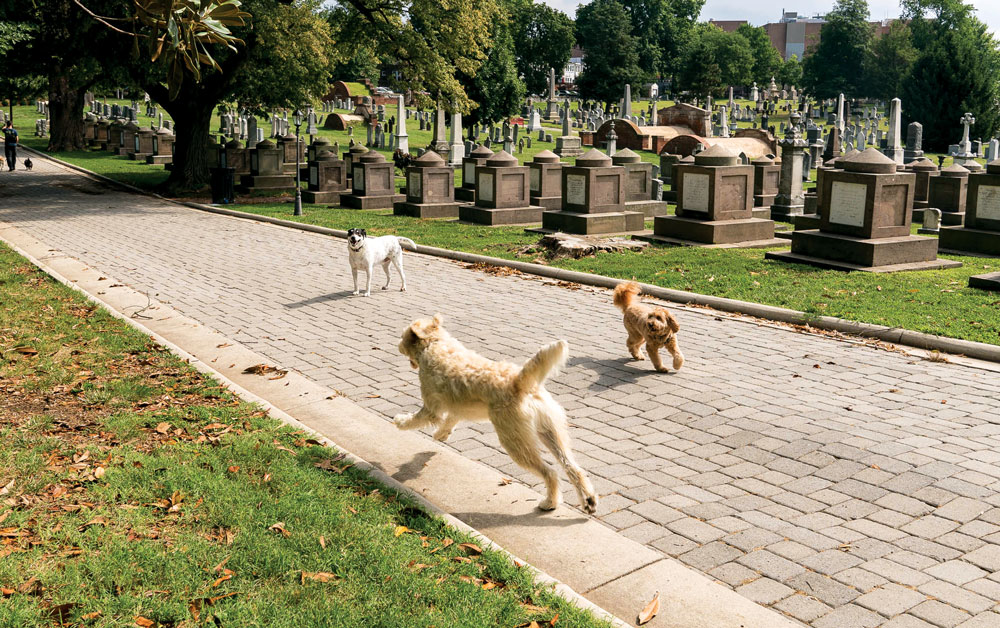

Dogs Give New Leash on Life To Abandoned Cemetery
Dogwalkers transform neglected cemetery into a beloved community space.
It’s a place where the living mingle with the dead, and dog owners and their pups are vying to get in. This remarkable spot is Washington D.C.’s Historic Congressional Cemetery (HCC), and it’s anything but frightening. In fact, the cemetery—the final resting place of many noteworthy Washingtonians, from congressmen to lauded LGBTQ soldiers and veterans—is arguably one of the country’s liveliest and most famous cemeteries. The cornerstone of its successful transformation? Its members-only dog walking program, bringing life, community, and volunteerism to this extraordinary burial ground.
Whoever said cemeteries are for the dead never met the members of the K9 Corps, the cemetery’s private dog walking program. (Dog walking at the cemetery is permitted by membership only.) “A huge part of my social circle here on the (Capitol) Hill is through my dog walking friends at the cemetery,” says Eric Dewaardt, who walks at the cemetery twice a day with Timmy, an 11-year-old English Shepherd, and Ellie Mae, a two-year-old terrier/black Lab mix.
A member of the K9 Corps since he moved to D.C. in 2003, Eric loves the cemetery because it is “beautiful, peaceful, historic, and has a vibrant social community.” While walking, Eric enjoys the sights—the gravestones of famous Washingtonians—and the quiet.
Eric’s involvement with the cemetery doesn’t stop there. In addition to belonging to the K9 Corps, Eric, a violist with the National Symphony Orchestra, runs Notes from the Crypt, a music series at the HCC’s chapel. The group puts on six concerts per year. The programs are just two of many held on the grounds of the HCC, aptly dubbed “America’s Hippest Cemetery.” There is also Day of the Dog, which features a full day of activities for dog lovers and their pets, as well as Cinemetery, a monthly movie series, a book club, a 5K race, docent-led historic walking tours, and Soul Strolls: Twilight Tours, which brings the stories of the cemetery to life with the help of costumed interpreters, says Sarah Kirspel, the HCC’s program director.
“People are able to…enjoy the grounds as a community space, which is in keeping with the spirit of the original purpose of the cemetery—bringing people together to celebrate loved ones,” says Sarah.
The HCC’s story is one of the things that makes the cemetery so special, says HCC president Paul Williams. In the 1980s and 1990s, it was abandoned, “with homeless, prostitutes, drug dealers, and weeds up to your neck,” he says. “It’s the dogwalkers that began to self-tax themselves to be able to hire someone to mow a path to a burial site in 1989 that began the entire program.”
Christine and Victor Romero, who have been walking their dogs at the HCC since 1988, were part of this group. “Back in those days, there was a lot of unsavory activity happening in the cemetery. With the presence of the dog walkers, that began to abate,” says Christine. The group helped the cemetery by raising funds, volunteering their time “and even mowing areas when a funeral was going to happen. Those with media, fundraising, accounting, and legal skills offered their services.” The K9 Corps was formalized in 1989.
“People relate to a disgraced cemetery and to before and after pictures to see just how far we have come,” says Paul. “Historic cemeteries have to get creative with revenue because in many cases they eventually fill up and site sales are no longer an option. We have about 5,000 sites left, which will take decades, but we want to create a long-term plan now for income for when that happens.”
That long-term plan includes the K9 Corps, which raises just over 20 percent (or $245,000) of the cemetery’s $1.2 million annual budget. An annual membership is $235, which is tax deductible, plus a $50 fee per dog to a maximum of three dogs.
“It was the dogwalkers that took your relative’s gravesite from an abandoned mess to the bucolic green space it is today,” says Paul. “Dogs also keep the wild animals at bay, and he calls the K9 community the cemetery’s “built-in security. We don’t have to worry about vandalism, kids drinking in the cemetery, (and) theft of artifacts that happen at almost every other cemetery.”
While dogs can run off-leash within the fenced-in grounds, the HCC is not a dog park, but a functioning cemetery first. With its first burial in 1807, the HCC is the final resting place of more than 65,000 people, and due to its proximity to Capitol Hill, many are historical figures. The first director of the FBI J. Edgar Hoover, composer and conductor of the U.S. Marine Band John Philip Sousa, silent film actress Mary Fuller, civil war photographer Mathew Brady, and Native American (Choctaw) Chief Push-Ma-Ta-Ha are all buried here. The cemetery’s public vault served as the temporary resting places of presidents John Quincy Adams, William Henry Harrison, and Zachary Taylor, as well as former first lady Dolley Madison.
“We’re also continuing to discover interesting ‘permanent residents’ when we dive into names and obits of those interred here,” says Paul. “For example, we recently found a young fellow that had been killed by a tiger in 1899 as part of a traveling circus, who was buried and left with no headstone—the show must go on—and when we brought that to light, the community raised $5,000 for a really nifty headstone, complete with the circus logo.”

You don’t have to have been famous to be buried at the HCC. Anyone can call the cemetery their final home, including animal family members. Last year, the HCC opened the Kingdom of Animals, which is a section just for pets. Christine and Victor plan to buy bricks to honour their past and present dogs, rescue Weimaraners Ludwig, KiMo, Roscoe, and Finn.
For the living, dog-walking privileges are limited to members of the K9 Corps during posted hours. There’s a schedule, making the park less convenient than taking dogs to the park or for a walk around the block, and a laundry list of rules, which include the display of membership tags, keeping dogs under control at all times, a limit of three K9 Corps dog members per human member, mandatory spaying, neutering, and up-to-date vaccination, and observing closure times to dogs (several hours on Saturdays and some holidays, as well as during burials and services). Dogs must be kept away from visitors, services, ceremonies, group tours, and grounds maintenance crew, leashed for entry and exit, and all users must respect cemetery monuments and grave markers. Dog toys are not allowed. Violation of any rules result in the revocation of membership, and in severe cases, permanent ban from the cemetery.
Despite the rules, the program is so popular that there are more than 400 people who paid a non-refundable fee to get on a waiting list for one of the 770 membership spots—“just the right number to avoid overcrowding,” says Paul. “It takes about four years to become a full member—depending on the election cycle here in DC as well. Lots of turnover after a presidential election if the party changes.”
“People are able to…enjoy the grounds as a community space, which is in keeping with the spirit of the original purpose of the cemetery—bringing people together to celebrate loved ones.”
Those who just want to access the cemetery for a day can get a one-day pass for $10 from the cemetery’s main office. Gate checkers may also have passes available on the weekend. “People appreciate the ability to walk their dogs in the cemetery and give them a chance to run around in a safe environment or give it a try before committing to the membership,” says Sarah.
Paul attributes the popularity of the program to several factors. “People on the Hill tend to have smallish homes with small backyards, and we offer a full, lush 35 acres to run and play,” he says. “It’s also a very social scene for the human owners—lots of friends made, socializing, and group visits.”
“It is a great outdoor space to relieve the stress of the workday world,” agrees Christine. “History is written on the stones. Every day—even 30 years later—I see something new. Dogs appreciate the opportunity to socialize with each other and their human friends. Some of our members enjoy walking in silent meditation with their pups on these sacred grounds. We have a chance to meet newcomers to the neighborhood. Congressional Cemetery may be the final resting place for D.C. residents, but it is also a thriving community of neighbours.”
Join the newsletter and never miss out on dog content again!
"*" indicates required fields
By clicking the arrow, you agree to our web Terms of Use and Privacy & Cookie Policy. Easy unsubscribe links are provided in every email.

